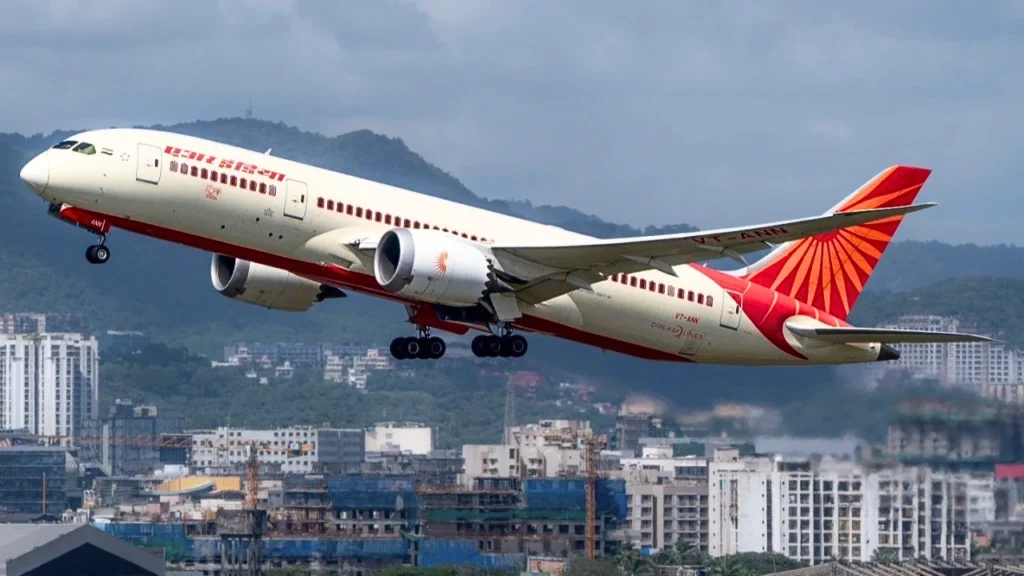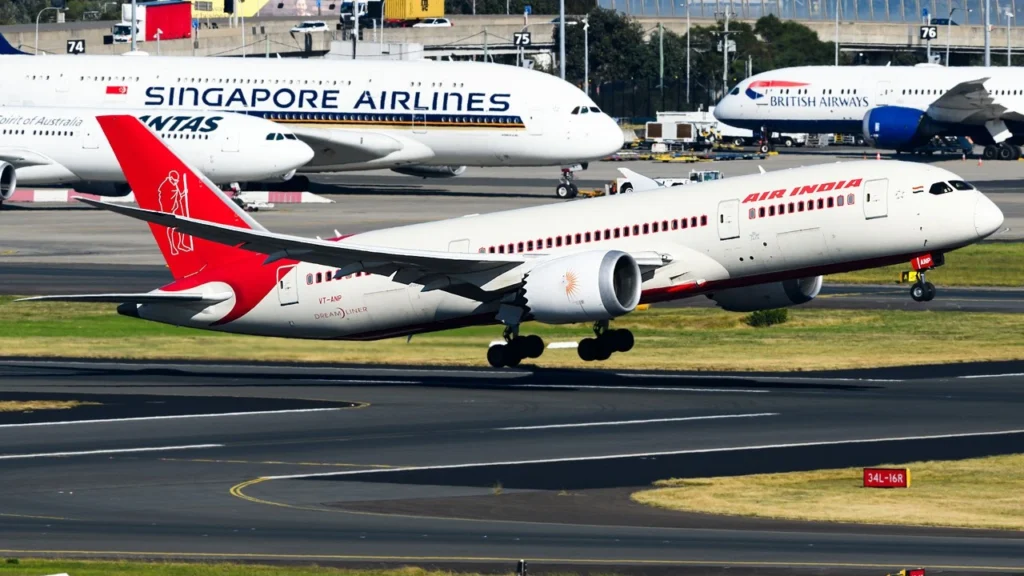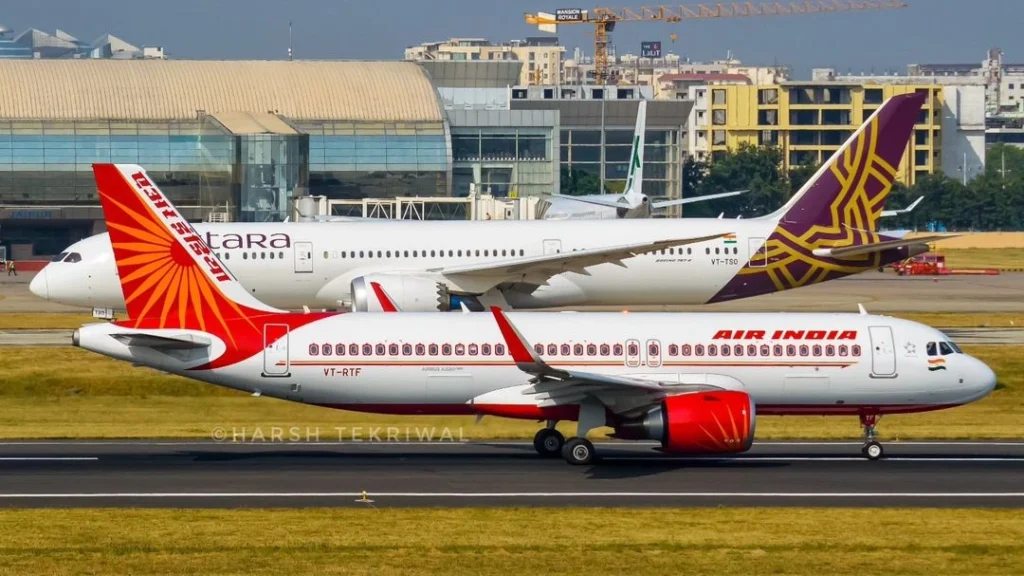DELHI- Tata-owned carrier Air India (AI), is making strategic moves to position itself as a key global transit airline. Air India wants to leverage India’s geographical advantage and state-of-the-art airport infrastructure in the country.
With an optimized flight network, the airline is working towards reducing layover times for passengers traveling between the UK, Europe, Australia, and South-East Asia, making international travel more seamless and efficient.
This initiative is part of Air India’s long-term vision to compete with leading global airlines and elevate India’s standing as a preferred transit point for international travelers.

Enhanced International Connectivity via India
Air India has strategically optimized its flight schedules to create faster and more efficient connections. The optimizations are made for travelers flying between Europe, Australia, and South-East Asia. The airline says that the flights are aligned in a way that reduces average layover times to just 2.5 hours.
The airline has also ensured that passengers no longer have to endure lengthy and tiresome waits between connecting flights. This streamlined approach makes Air India a highly competitive choice. This can offer a smooth alternative to well-established transit hubs such as Dubai, Doha, and Singapore.
To raise awareness about these enhanced travel options, Air India has launched a dedicated marketing campaign titled ‘Via’. This initiative highlights the advantages of choosing Air India for international travel.
The program also emphasizes the enhanced transit experience at Delhi and Mumbai airports. These airports will have faster connectivity between major global destinations, and a travel experience that combines comfort with efficiency.
Air India is showcasing India as a world-class aviation hub. The airline aims to attract more international passengers to use its transit services. This initiative is particularly beneficial for passengers traveling on long-haul routes. Shorter layovers can make a significant difference in the overall travel experience of travelers.
Whether flying from London to Sydney or Frankfurt to Singapore, Air India’s optimized network ensures that travelers reach their destinations faster and with greater ease.

Seamless Transit Experience at Delhi and Mumbai Airports
A crucial element of Air India’s improved connectivity strategy lies in the efficiency of its major hubs. This includes two of its hubs, Indira Gandhi International Airport (Delhi) and Chhatrapati Shivaji Maharaj International Airport (Mumbai).
Both airports have earned a reputation for their world-class infrastructure, cutting-edge technology, and seamless passenger handling capabilities. For travelers transiting through Delhi’s Terminal 3 (T3) and Mumbai’s Terminal 2 (T2), the experience is designed to be as smooth and stress-free as possible.
Many international airports requires passengers to navigate through multiple terminals to catch their connecting flights. However, Air India has made sure that the transit will be hassle-free. Air India has ensured that its transit operations take place within the same terminal at both Delhi and Mumbai Airports.
This eliminates the inconvenience of long walks or re-checking baggage, allowing passengers to move swiftly from one flight to another. Additionally, the automated baggage handling system at these airports ensures that checked luggage is efficiently transferred between connecting flights.
This new baggage handling system eliminates the risk of delays or misplacements. Both of these airports have streamlined immigration and security clearance procedures, which will further reduce processing times. This enables passengers to complete the procedures in the shortest time possible.
To enhance the overall travel experience, Air India provides exclusive lounge access for premium travelers. Air India’s Business Class passengers, Maharaja Club members, and eligible Star Alliance members are eligible for the lounge access.
The lounges offer a range of luxury services, including gourmet dining, spas, and relaxation zones. These new lounges also include business workspaces and high-speed Wi-Fi, catering to both leisure and business travelers. By integrating comfort with convenience, Air India is ensuring that transit through India is as effortless and enjoyable as possible.

Air India and Singapore Airlines Codeshare Expansion
Alongside the improvements in flight scheduling, Air India has also strengthened its global reach by expanding its codeshare agreements with Singapore Airlines. Air India has enabled passengers a hassle-free connection across multiple international destinations.
These efforts are a testament to Air India’s commitment to enhancing its service quality and passenger experience on a global scale. To further expand its international footprint, Air India has strengthened its global connectivity through an expanded codeshare agreement with Singapore Airlines.
This strategic move enhances the airline’s presence across key international markets, allowing travelers to seamlessly connect to more destinations under a single booking. The expanded codeshare agreement improves access from Singapore to various European cities, Sri Lanka. Air India will enhance connectivity with additional routes between UK and Singapore via India.
Through this partnership, passengers will benefit from a streamlined travel experience. This includes coordinated flight schedules, seamless baggage transfers, and smooth check-in procedures across connecting flights.
This means that travelers flying on Air India’s network can easily transition to their final destination without the need for multiple bookings or separate check-ins. The extended partnership also increases flight frequencies between India and major international hubs, providing passengers with greater flexibility in planning their journeys.

What to expect?
As Air India continues its transformation journey, its focus remains on enhancing efficiency, expanding global partnerships, and improving passenger experience. The airline’s commitment to reducing connection times, upgrading airport facilities, and strengthening international collaborations is paving the way for it to become a preferred choice for long-haul international travel.
Over the past few years, the airline will have an upgraded fleet, premium seating options, and a renewed focus on passenger comfort. With this, Air India is steadily building a modern and competitive identity on the global stage.
These initiatives mark a significant step toward positioning India as a premier transit hub. The airline is ensuring that passengers traveling between the East and the West find India to be the most convenient and efficient stopover point.
By leveraging such collaborations, Air India is reinforcing its position as a major global airline, ensuring that travelers have more options, greater convenience, and a world-class experience.
Passengers will have the option to transit through two of the biggest Indian airports, Delhi and Mumbai. Air India is likely to introduce a 3rd option to the passengers as well in the future. The airline’s 3rd hub in Southern India – Bengaluru.
As the airline continues to invest in its future, passengers can expect more seamless travel experiences, enhanced service offerings, and an expanding network of global destinations, solidifying Air India’s status as a world-class carrier in the years to come.
Stay tuned with us. Further, follow us on social media for the latest updates.
Join us on Telegram Group for the Latest Aviation Updates. Subsequently, follow us on Google News

